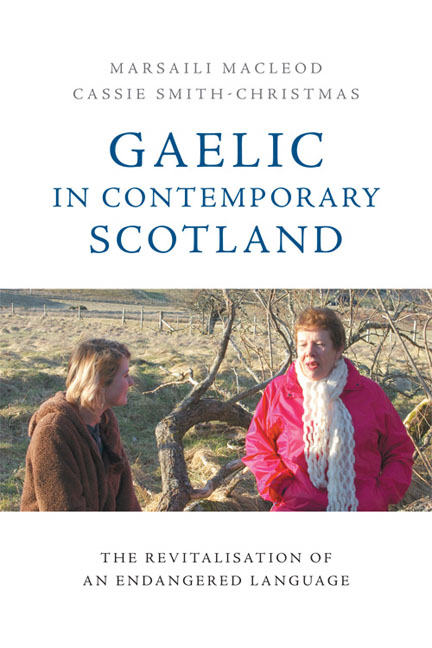Book contents
- Frontmatter
- Contents
- List of Figures
- List of Tables
- Notes on Contributors
- Foreword: Assailed yet Resolute
- Acknowledgements
- List of Abbreviations
- 1 Introduction
- 2 The Language of the Playground: Activists Building Consensus on the Language Policy and Ethos of a New Gaelic Immersion School
- 3 Mismatches between National and Local Gaelic Development: Cròileagan Dùn Èideann and the Promotion of Gaelic-medium Education
- 4 Gaelic amongst Schoolchildren: Ideas on Language Change and Linguistic Choices in Gaelic
- 5 When School is Over and Done With: Linguistic Practices and Sociodemographic Profiles of Gaelic-medium Educated Adults
- 6 New Speakers of Gaelic: A Historical and Policy Perspective
- 7 Learning Gaelic in Adulthood: Second Language Learning in Minority Language Contexts
- 8 Dlùth is Inneach: Charting Language Ideology in the Contemporary Gaelic World
- 9 Gaelic Language Use in Public Domains
- 10 Planning for Growth: The Professionalisation of the Taskforce for Gaelic Revitalisation
- 11 Organisational Language Planning: Gaelic Language Plans in the Public Sector
- 12 The Future of Gaelic Language Revitalisation in Scotland
- Index
9 - Gaelic Language Use in Public Domains
Published online by Cambridge University Press: 18 December 2019
- Frontmatter
- Contents
- List of Figures
- List of Tables
- Notes on Contributors
- Foreword: Assailed yet Resolute
- Acknowledgements
- List of Abbreviations
- 1 Introduction
- 2 The Language of the Playground: Activists Building Consensus on the Language Policy and Ethos of a New Gaelic Immersion School
- 3 Mismatches between National and Local Gaelic Development: Cròileagan Dùn Èideann and the Promotion of Gaelic-medium Education
- 4 Gaelic amongst Schoolchildren: Ideas on Language Change and Linguistic Choices in Gaelic
- 5 When School is Over and Done With: Linguistic Practices and Sociodemographic Profiles of Gaelic-medium Educated Adults
- 6 New Speakers of Gaelic: A Historical and Policy Perspective
- 7 Learning Gaelic in Adulthood: Second Language Learning in Minority Language Contexts
- 8 Dlùth is Inneach: Charting Language Ideology in the Contemporary Gaelic World
- 9 Gaelic Language Use in Public Domains
- 10 Planning for Growth: The Professionalisation of the Taskforce for Gaelic Revitalisation
- 11 Organisational Language Planning: Gaelic Language Plans in the Public Sector
- 12 The Future of Gaelic Language Revitalisation in Scotland
- Index
Summary
Introduction
Decennial census data from the late nineteenth century onwards has shown a sharp decrease in the number of Gaelic speakers in Scotland, in absolute terms, but also as a percentage of the population; whereas in 1891 254,415 people, 6.3 per cent of the total population of Scotland, were recorded as being ‘in the habit of making colloquial use of the Gaelic language’ (Census Office 1893), by 2011 this had fallen by 85 per cent to 57,375 people, 1.1 per cent of the population, self-reporting to be able to speak the language (National Records of Scotland (NRS) 2013). This decline in numbers of speakers has also been accompanied by a contraction in the geographical regions where the language is spoken by a majority of the population; whereas in 1901 Gaelic was spoken by more than 75 per cent of the population in the Inner and Outer Hebrides and, with the exception of North Mull, ‘all mainland parishes in an unbroken line from Appin in the south to Farr in the North’ (Mac an Tàilleir 2010: 33), in 2011 no parish remained where more than 67 per cent of the population claimed to be able to speak the language (NRS 2013). With research conducted in the Gaeltacht in Ireland by Ó Giollagáin et al. (2007) suggesting that the proportion of active, integrated minority language speakers needs to be more than 67 per cent for the use of the language in the community to be sustainable, it is therefore likely that Gaelic is continuing to yield to English as the main language used in communities, even in last remaining ‘heartland’ of the language, the Western Isles, where more than half the population are still able to speak Gaelic (NRS 2013).
This continuing language shift from Gaelic to English should be set against various support initiatives from the early twentieth century onwards, initially aimed at sup-porting and developing the fragile economic status of the traditional heartland of the language, the Gàidhealtachd. Although economic status has been identified by Grenoble and Whaley as ‘maybe the single strongest force influencing the fate of endangered languages’ (1998: 125), with Crystal (2000: 132) acknowledging that ‘an endangered language will progress if its speakers increase their wealth relative to the dominant community’, no official consideration was given to supporting the Gaelic language itself until the 1980s.
- Type
- Chapter
- Information
- Gaelic in Contemporary ScotlandThe Revitalisation of an Endangered Language, pp. 128 - 140Publisher: Edinburgh University PressPrint publication year: 2018

